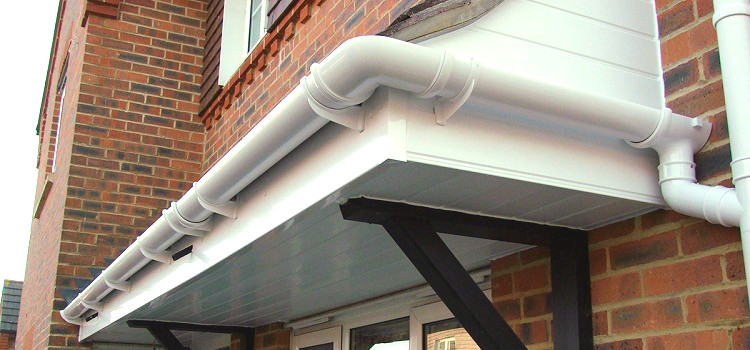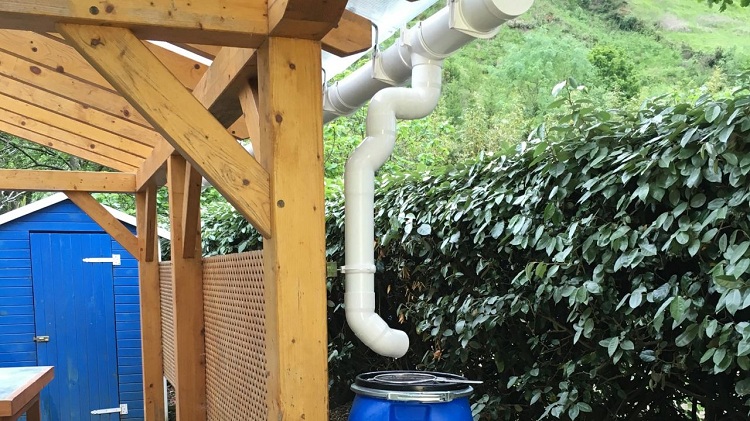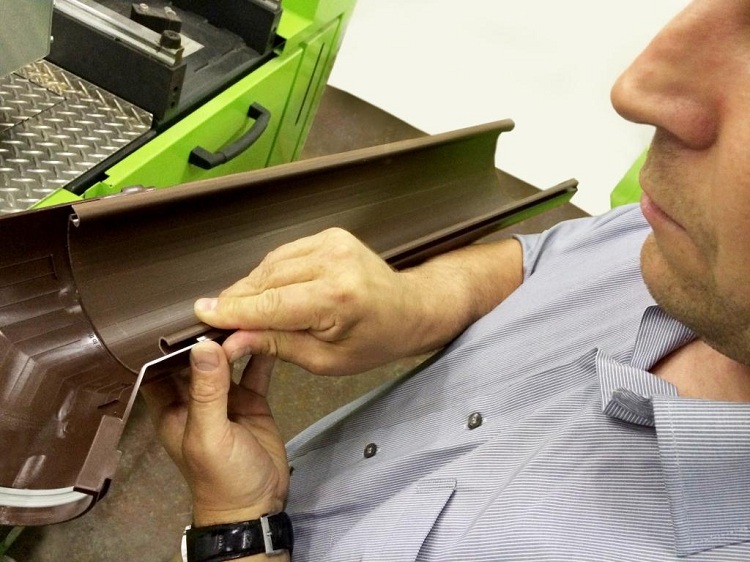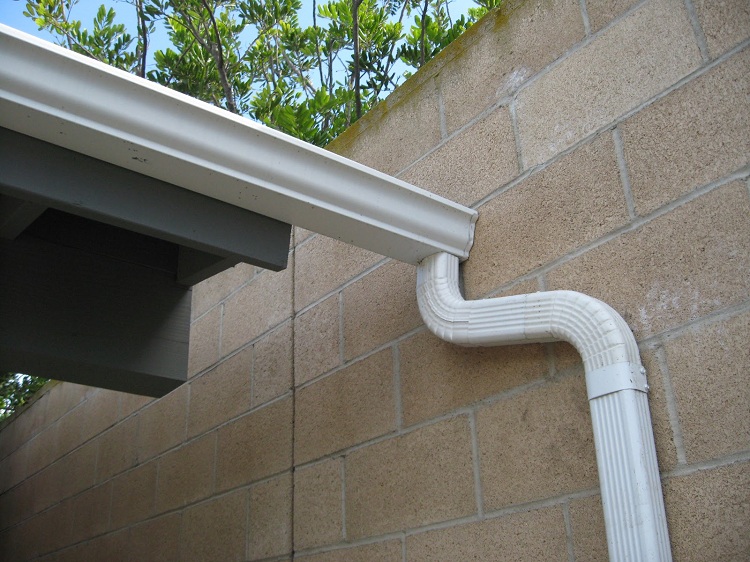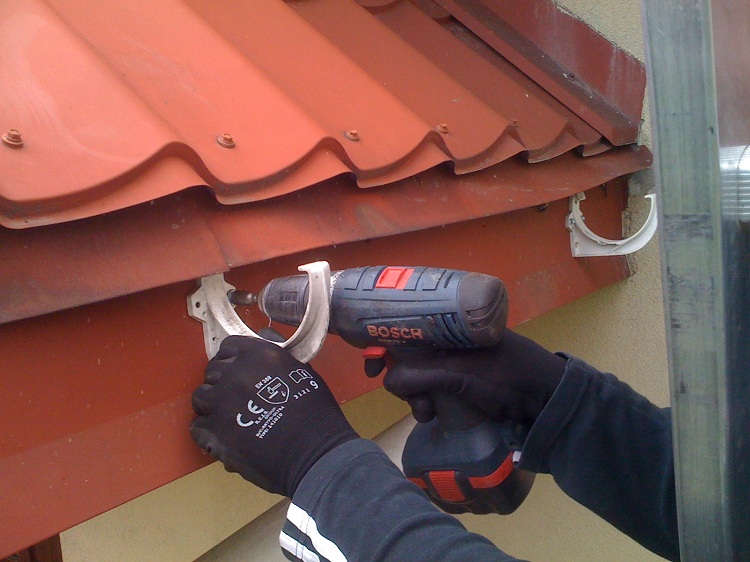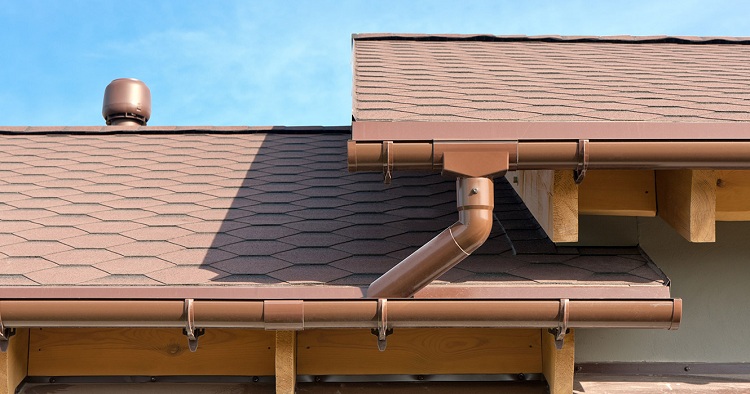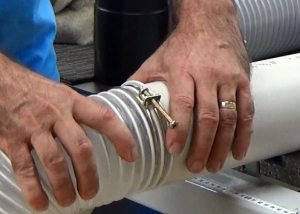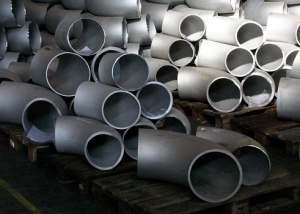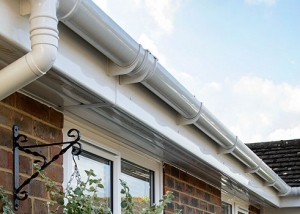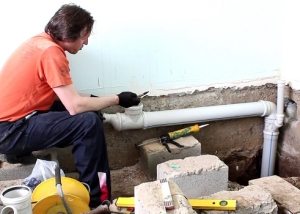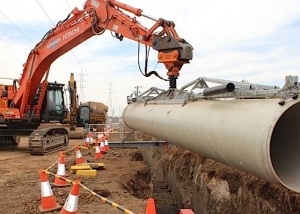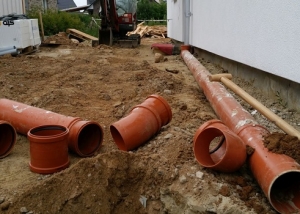A gutter is a system of pipes, gutters and drains that drains rain and melt water from the roof of the house to the desired location (for example, a drainage network). In addition, the drainage system protects the walls and foundation of the house from the damaging effects of water. The plastic construction has some advantages over other types of gutter systems.
Content
What are gutters for?
When installing the roof, slopes are always provided for which natural moisture will flow. However, during heavy rainfall, the slope is ineffective. If the ramp is too sharp, then rainwater flows at high speed and randomly falls on the foundation or lawn, destroying them. If the angle of inclination is too small, precipitation accumulates on the roof and creates additional load on the structure.
The gutter system allows you to organize the process of water drainage from the roof, as well as prevent the falling of melted snow and ice accumulations, which can not only damage the coating in the yard, but also cause injury to a person who is in the danger zone. The main functions of drainage systems are the following factors:
- Protects the foundation from destruction.
- Prevents snow from falling from the roof.
- With the help of the system it is possible to carry out full control on the removal of wastewater to the desired location.
The advantages of plastic gutters
Today, owners of private homes often install plastic gutters. Basically, such products are made of PVC. They have a number of advantages over parts from other materials.
The main ones are:
1. Atmospheric phenomena affect them not in the best way. The service life of galvanized products ranges from 5 to 7 years. In turn, PVC gutters are not susceptible to the harmful effects of corrosion and can last several decades.
2. Strength. Steel, of course, has higher strength indicators, but in general, plastic gutters have good technical characteristics and withstand all the necessary loads under normal operating conditions.
Note! PVC structures can be selected in shapes and colors that will match the design you need.
3. Resistance to environmental influences. Plastic parts do an excellent job and have good heat resistance. They are able to function at temperatures from - 40 to + 50 ° C.
4. Lack of hydraulic resistance. PVC pipes have a smooth inner surface, which allows them to freely drain water from the roof. In addition, the absence of roughness does not allow garbage to accumulate in the pipes, which prevents clogging.
5. Tightness. PVC constructions have high leakage rates. With proper installation of the pipes, water leakage is almost impossible.
6. Light weight. Compared to steel counterparts, plastic drains weigh less, which greatly simplifies their transportation and installation.
The main elements of the gutter structure
First of all, before installing the drainage system, you need to prepare all the necessary elements, as well as a tool.
The main elements of drainage systems include:
Gutter. This element of the gutter structure is a channel for collecting liquid, which descends during the rainfall on the roof surface. They are specially placed on a slope towards the funnel. This ensures that water flows into the pipes without overflowing the gutters. It is the gutters that collect water and prevent it from falling onto the foundation of the building and the soil around it.
Vertical pipes. These parts perform the function of transporting waste water in the right direction. As a rule, drainpipes are equipped with a bend at the surface of the earth or slightly higher, which allows directing water to the drainage system, sewage system or to a specially designated tank. The water collected in the tanks can be used for household purposes. Vertical pipes are fixed on the walls of the house with the help of special accessories. PVC pipes, as mentioned above, are lightweight and their installation is simpler; it does not require welding to assemble or secure the system.
Plums. These elements are the link between the gutters and pipes. Plums perform the branching function in the joints of gutters and pipes.
Types of gutters made of PVC
Drains plastic for a roof can have a different type of section: round, figured, rectangular. Pipes with square and figured cross-section, as a rule, are used to diversify the decor of the house. However, it is worth considering that pipes with a circular cross-section have better throughput characteristics.
Helpful information! A very important point is that at temperature jumps of 10 ° C the elements that are made of plastic can change their sizes. The part changes by about 0.7 mm / linear. m. Because of this, special brackets are used to fix the gutters. They firmly fix the gutter and prevent its movement along the eaves.
In addition, plastic drains are divided into two categories:
- mounted (external);
- internal.
Mounted gutters are very popular and have such advantages:
- ease of installation. Their installation does not require special building skills;
- the design is almost maintenance free;
- when installing mounted gutters, special tools are not required.
Inland gutters are ideal for removing atmospheric precipitation from private houses that have a flat roof, or multi-story buildings. Such a drainage system is mounted directly in the roof. As a rule, it is installed at a certain angle to the roof itself. This allows unhindered water flow.
A very important point is the correct calculation of the diameter of the pipes. It depends on whether they will cope with their functions during operation.
Features of the calculation of the necessary materials
When performing work on the calculation of materials for the drainage system, you should be careful not to make a mistake in the numbers and buy all the necessary components. The calculation is carried out taking into account the type of roof, climatic features of a particular region.
First of all, it is worth making a drawing of the roof plan in order to calculate its area.
It is necessary to consider:
- roof height;
- bevel angle;
- the length of the overhang that the roof has.
After that, the desired pipe diameter is calculated. Products must have the necessary throughput indicators for each specific case.If the structure cannot cope with its task, then water will flow over the edge and sooner or later will harm the foundation of the building. The dependence of throughput indicators on the diameter of the pipes is presented in the table.
Table 1
| Pipe diameter (mm) | Water consumption (l / s) |
| 150 | 50 |
| 85 | 10 |
| 200 | 80 |
| 100 | 20 |
To simplify the calculation, you can use the drawing, which will contain all the necessary numbers and calculations. Installation of gutters is carried out around the entire perimeter of the roof, in those places where there is a slope. The gutter has a standard size of 3 m.
In order to quickly calculate the required number of gutters that you will need in installation, it is necessary to divide the length of the roof by the size of 1 gutter.
Fixture for plastic drains is carried out every 0.6 m. The calculation of the required number of brackets is carried out according to a simple formula - the length of the roof must be divided by 0.6. The connecting elements for joining the gutters are used exactly 2 times less than the parts themselves. Do not forget about the stubs. Stubs are special elements that are installed at the beginning and at the end of the cornice, they play the role of ends.
When installing drain plastic pipes, it is worth calculating the required number of transitions. To do this, use the rule: one funnel must have two transitional elbows and one drain. This principle applies if the building has smooth walls.
Important! If the walls of your house are decorated with ledges, then for each such element it is worth adding 2 knees.
To determine the number of pipes, you need to divide the wall height by 3 (the standard length of the drainpipe) and multiply by the number of funnels.
Mounting with clamps is performed so that the distance between them corresponds to 1 meter.
table 2
| Slope area (m²) | Pipe diameter (mm) | Trench Diameter (mm) |
| 50-100 | 100 | 150 |
| Over 100 | 125 | 200 |
| Up to 50 | 75 | 100 |
Following these formulas and rules, you can save yourself time, and most importantly, nerves. It is very important to be careful when calculating. It is recommended that you double-check the calculations for accuracy. This will save you from problems in installing a drainage system made of plastic.
Installation Steps
Installation of a gutter structure can be performed both with your own hands and with the help of specialists.
1. At the first stage of installation, you should choose a place for mounting the structure. The location of the PVC gutters should correspond to the convenient ingress of water into them. It is worth remembering that one funnel should drain liquid from a section of the gutter, which has a length of up to 12 meters. The design is mounted at an angle to the sewer in order to make draining the water as efficient as possible. With each meter, the gutter slope should be approximately 5 mm.
After all the calculations for the displacement of the gutter, it is worth marking the location of the brackets (40 cm from each other). Then the fasteners are installed.
2. At the second stage of installation, the gutter structure is directly installed. To begin with, it is recommended to measure and mark all the parameters of the house, taking into account the protrusions, etc. After this, the fastening of the profile elements is carried out. The elements are connected with special glue or connecting parts.
The main disadvantage of connecting the pipes with glue is that it is then practically impossible to disconnect them without damage. The connecting parts in this regard are much more convenient and the dismantling of the structure is quite simple.
After combining the structure, it is installed with special latches on the brackets.
Important! Pay attention to where the mounting points of the structure to the brackets are. They should not fall on drain funnels.
After this, funnels are mounted, and special plugs are installed along the edges of the gutters.
3. At the last stage, the drain pipes are installed.Pipes are installed under sewage funnels. When placing the pipe on the wall of the building, it is worthwhile to ensure that it is strictly vertical without any deviations. Work is underway to connect all the details of the plastic water supply. Places where the clamps are located should be noted. This is done in order to determine how far they are from each other. It should correspond to 1 m. The clamps are attached to the wall. The distance from the wall to the pipe should be at least 2 cm. At the very end, the drain is brought to the necessary place where water from the roof will merge.
A properly organized gutter will protect the landscape of the courtyard, as well as the residential building, from the destructive effects of water flowing from the roof. Such a system is necessary, and its creation must be taken seriously.
